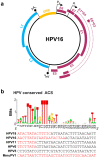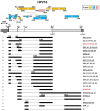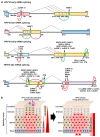HPV16 and HPV18 Genome Structure, Expression, and Post-Transcriptional Regulation
- PMID: 35563334
- PMCID: PMC9105396
- DOI: 10.3390/ijms23094943
HPV16 and HPV18 Genome Structure, Expression, and Post-Transcriptional Regulation
Erratum in
-
Correction: Yu et al. HPV16 and HPV18 Genome Structure, Expression, and Post-Transcriptional Regulation. Int. J. Mol. Sci. 2022, 23, 4943.Int J Mol Sci. 2022 Jul 18;23(14):7903. doi: 10.3390/ijms23147903. Int J Mol Sci. 2022. PMID: 35887403 Free PMC article.
Abstract
Human papillomaviruses (HPV) are a group of small non-enveloped DNA viruses whose infection causes benign tumors or cancers. HPV16 and HPV18, the two most common high-risk HPVs, are responsible for ~70% of all HPV-related cervical cancers and head and neck cancers. The expression of the HPV genome is highly dependent on cell differentiation and is strictly regulated at the transcriptional and post-transcriptional levels. Both HPV early and late transcripts differentially expressed in the infected cells are intron-containing bicistronic or polycistronic RNAs bearing more than one open reading frame (ORF), because of usage of alternative viral promoters and two alternative viral RNA polyadenylation signals. Papillomaviruses proficiently engage alternative RNA splicing to express individual ORFs from the bicistronic or polycistronic RNA transcripts. In this review, we discuss the genome structures and the updated transcription maps of HPV16 and HPV18, and the latest research advances in understanding RNA cis-elements, intron branch point sequences, and RNA-binding proteins in the regulation of viral RNA processing. Moreover, we briefly discuss the epigenetic modifications, including DNA methylation and possible APOBEC-mediated genome editing in HPV infections and carcinogenesis.
Keywords: RNA polyadenylation; RNA splicing; epigenetic modification; genome structure; papillomaviruses.
Conflict of interest statement
The authors declare no conflict of interest.
Figures






Similar articles
-
Serine/Arginine-Rich Splicing Factor 3 and Heterogeneous Nuclear Ribonucleoprotein A1 Regulate Alternative RNA Splicing and Gene Expression of Human Papillomavirus 18 through Two Functionally Distinguishable cis Elements.J Virol. 2016 Sep 29;90(20):9138-52. doi: 10.1128/JVI.00965-16. Print 2016 Oct 15. J Virol. 2016. PMID: 27489271 Free PMC article.
-
Human Papillomavirus 16 Oncoprotein Expression Is Controlled by the Cellular Splicing Factor SRSF2 (SC35).J Virol. 2015 May;89(10):5276-87. doi: 10.1128/JVI.03434-14. Epub 2015 Feb 25. J Virol. 2015. PMID: 25717103 Free PMC article.
-
The E7 oncoprotein is translated from spliced E6*I transcripts in high-risk human papillomavirus type 16- or type 18-positive cervical cancer cell lines via translation reinitiation.J Virol. 2006 May;80(9):4249-63. doi: 10.1128/JVI.80.9.4249-4263.2006. J Virol. 2006. PMID: 16611884 Free PMC article.
-
Papillomavirus genome structure, expression, and post-transcriptional regulation.Front Biosci. 2006 Sep 1;11:2286-302. doi: 10.2741/1971. Front Biosci. 2006. PMID: 16720315 Free PMC article. Review.
-
Regulation of human papillomavirus gene expression by splicing and polyadenylation.Nat Rev Microbiol. 2013 Apr;11(4):239-51. doi: 10.1038/nrmicro2984. Epub 2013 Mar 11. Nat Rev Microbiol. 2013. PMID: 23474685 Review.
Cited by
-
Clinical applications and utility of ctDNA in cervical cancer and its precursor lesions: from screening to predictive biomarker.Cancer Cell Int. 2023 Dec 18;23(1):329. doi: 10.1186/s12935-023-03132-0. Cancer Cell Int. 2023. PMID: 38110977 Free PMC article. Review.
-
A Self-Amplifying Human Papillomavirus 16 Vaccine Candidate Delivered by Tobacco Mosaic Virus-Like Particles.ACS Appl Bio Mater. 2024 Nov 18;7(11):7675-7683. doi: 10.1021/acsabm.4c01239. Epub 2024 Nov 8. ACS Appl Bio Mater. 2024. PMID: 39512153 Free PMC article.
-
Advances in human papillomavirus detection for cervical cancer screening and diagnosis: challenges of conventional methods and opportunities for emergent tools.Anal Methods. 2025 Feb 13;17(7):1428-1450. doi: 10.1039/d4ay01921k. Anal Methods. 2025. PMID: 39775553 Free PMC article. Review.
-
C-71980262, a novel small molecule against human papilloma virus-16 E6 (HPV-16 E6) with anticancer potency against cervical cancer: A computational guided in vitro approach.Iran J Basic Med Sci. 2024;27(11):1389-1396. doi: 10.22038/ijbms.2024.78090.16882. Iran J Basic Med Sci. 2024. PMID: 39386235 Free PMC article.
-
Upregulation of HPV16E1 and E7 expression and FOXO3a mRNA downregulation in high-grade cervical neoplasia.PeerJ. 2024 Dec 6;12:e18601. doi: 10.7717/peerj.18601. eCollection 2024. PeerJ. 2024. PMID: 39655333 Free PMC article.
References
-
- Pastrana D.V., Peretti A., Welch N.L., Borgogna C., Olivero C., Badolato R., Notarangelo L.D., Gariglio M., FitzGerald P.C., McIntosh C.E., et al. Metagenomic Discovery of 83 New Human Papillomavirus Types in Patients with Immunodeficiency. mSphere. 2018;3:e00645-18. doi: 10.1128/mSphereDirect.00645-18. - DOI - PMC - PubMed
Publication types
MeSH terms
Substances
Grants and funding
LinkOut - more resources
Full Text Sources

